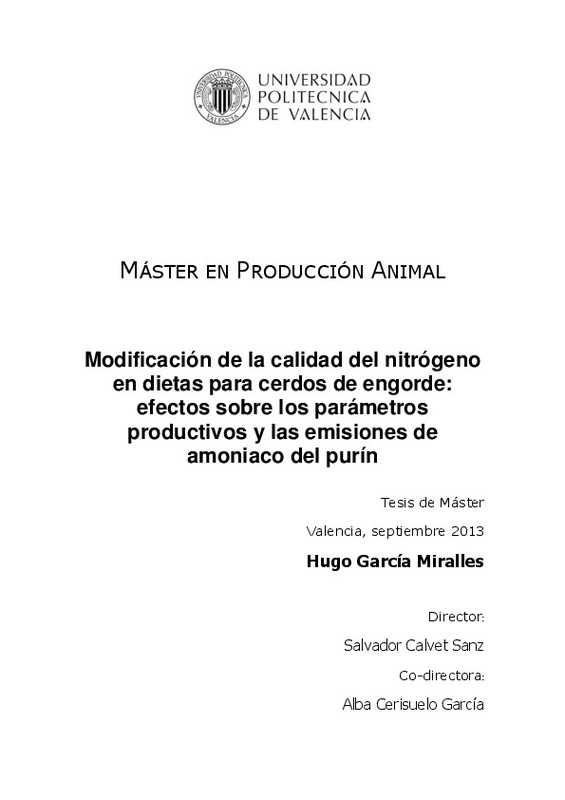|
Resumen:
|
[ES] Se evaluaron los efectos de 3 dietas de igual valor nutricional en cerdos de cebo, modificando los ingredientes, y por tanto el aporte de nitrógeno ligado a fibra de la ración y la fuente proteica, sobre los parámetros ...[+]
[ES] Se evaluaron los efectos de 3 dietas de igual valor nutricional en cerdos de cebo, modificando los ingredientes, y por tanto el aporte de nitrógeno ligado a fibra de la ración y la fuente proteica, sobre los parámetros productivos, y sobre las características de los purines en las emisiones amoníaco. Se formularon un total de 3 piensos que incluían distintas fuentes de proteína (Soja, DDGS y Girasol).
El ensayo se realizó en condiciones de digestibilidad controladas, teniendo en cuenta, el estado fisiológico de los animales, utilizando muestras extraídas únicamente de los experimentos controlados, con el fin de evaluar sus patrones de excreción de nutrientes, la composición del efluente y el potencial de producción de amoníaco. Se llevaron a cabo con 12 jaulas metabólicas ubicadas en una habitación a temperatura controlada de la unidad de porcino, en el Centro Experimental de Investigación y Tecnología Animal (CITA-IVIA) perteneciente al Instituto Valenciano de Investigaciones Agrarias (IVIA), ubicado en Segorbe (Castellón). Cada tratamiento ensayado, utilizó 8 animales por tratamiento, 24 animales en total (8*3 tratamientos), y se realizaron 2 tandas de 4 animales por tratamiento, de alrededor de 40-50 kg de peso.
Los animales se colocaron individualmente en jaulas metabólicas durante 5 días para la adaptación seguidos por un período de recogida de muestras de 8 días aproximadamente, de acuerdo a Jarret et al. (2010). Se realizo un ensayo de digestibilidad con las muestras que provenían de los 4 primeros días de muestreo, y un ensayo de emisiones con las muestras recogidas los últimos tres días de muestreo.
Los parámetros productivos de consumo de pienso y agua, peso, crecimiento y excreción de orina y heces, no mostraron diferencias significativas, en el ensayo de digestibilidad. En el ensayo de emisiones, los purines asociados a los piensos que incorporaron girasol y DDGS tuvieron mayores emisiones de NH3 que el pienso a base de soja. Las diferencias encontradas en los valores de nitrógeno ligado a fibra entre los piensos y las variaciones del pH en la orina y heces excretados pueden explicar la variación encontrada en las emisiones de NH3.
[-]
[EN] The effects of 3 diets of equal nutritional value in finishing pigs modified the ingredients, and therefore the contribution of bound nitrogen ration fiber and protein source on performance, and the characteristics ...[+]
[EN] The effects of 3 diets of equal nutritional value in finishing pigs modified the ingredients, and therefore the contribution of bound nitrogen ration fiber and protein source on performance, and the characteristics of slurry in ammonia emissions. He made a total of 3 different feed protein sources included (Soybean, and Sunflower DDGS).
The test was conducted in controlled conditions digestibility, taking into account the physiological state of animals using only samples from controlled experiments in order to evaluate their excretion patterns nutrient effluent composition and production potential ammonia. Were conducted with 12 metabolic cages placed in a room at controlled temperature of the pig unit in the Center for Experimental Animal Research and Technology (CITA- IVIA) of the Instituto Valenciano de Investigaciones (IVIA) located in Segorbe (Castellón). Each treatment tested, 8 animals per treatment used, 24 animals in total (8*3 treatments), and 2 batches were made of 4 animals per treatment of about 40-50 kg.
Animals were placed individually in metabolic cages for 5 days followed by an adaptation sampling period of approximately 8 days, according to Jarret et al. (2010). We performed a digestibility trial with samples coming from the first 4 days of sampling, and emissions test samples collected the last three days of sampling.
Performance parameters of feed and water consumption, weight, growth and excretion of urine and feces no significant differences in the digestibility trial. In emission testing, slurry feed associated with sunflower incorporated DDGS had higher NH3 emissions that soy-based feed. The differences in values between fiber bound nitrogen feed and pH variations in the urine and feces excreted may explain the variation found in the emission of NH3.
[-]
|







